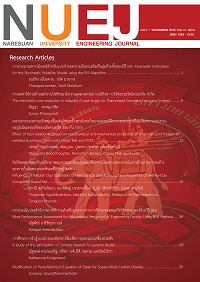A study of tourist perceptions for jewelry design
Main Article Content
Abstract
Article Details
References
D. A. Norman. Emotional Design: Why We Love (or Hate) Everyday Things, New York: Basic Books, 2004, pp. 3-13.
D. G. Myers, Psychology, 7th ed., New York: Worth Publishers, 2004, pp. 3-25.
N. Crilly, J. Moultrie and P. J. Clarkson, “Seeing things: consumer response to the visual domain in product design,” Design Studies, vol. 25(6), pp. 547-577, 2004.
A. G. HO and K. W. M. Siu, “Emotionalise Design, Emotional Design, Emotion Design: A new perspective to understand their relationships,” in Proc. of the International Association of Societies of Design Research 2009 - IASDR 2009, Seoul, South Korea, pp. 2717-2726, 2009.
ณัฐพงษ์ คงประเสริฐ, “การออกแบบผลิตภัณฑ์เพื่อให้ตอบสนองกับความต้องการของลูกค้า,” วารสารวิศวกรรมศาสตร์ มหาวิทยาลัยศรีนครินทรวิโรฒ, ฉบับที่ 10(1), หน้า 53-63, 2558.
N. Kongprasert, “Emotional design approach to design teak wood furniture,” in Proc. of the Asia Pacific Industrial Engineering & Management Systems Conference 2012 (APIEMS 2012), Phuket, Thailand, pp. 805-812, 2012.
N. Kongprasert, “How to extract knowledge from fashion experts through emotional design approach,” in Proc. of the International Conference on Marketing Studies (ICMS 2012), Bangkok, Thailand, pp. 155-165, 2012.
T. Jindo and K. Harasago, “Application studies to car interior of Kansei engineering,” International Journal of Industrial Ergonomics, vol. 19, pp. 105-114, 1997.
S. Schutte and J. Eklund, “Design of rocker switches for work-vehicles—an application of Kansei Engineering,” Applied Ergonomics, vol. 36, pp. 557-567, 2005.
C. Bouchard, F. Mantelet, A. Aoussat, C. Solves, C.J. Gonzales, S. Coleman and K. Pearce, “A European emotional investigation in the field of shoes design,” International Journal of Product Development, vol. 7, No. 1/2, pp. 3-27, 2009.
P. M. A. Desmet, “Emotion through expression; designing mobile telephones with an emotional fit,” Report of Modeling the Evaluation Structure of KANSEI, vol. 3, pp. 103-110, 2000.
A. Warell, C. Fjellner and J. Stridsman-Dahlström, “Visual product identity: Understanding identity perceptions conveyed by visual product design,” in Proc. of the 5th International Conference on Design & Emotion 2006, Sweden, pp. 245-260, 2006.
J. N. Kapferer, New strategic brand management: creating and sustaining brand equity long term, Kogan Page, 2008, pp. 171-175.
T.M. Karjalainen, “It looks like a Toyota: Educational approaches to designing for visual brand recognition,” International Journal of Design, vol. 1, No. 1, pp. 67-81, 2007.
J. P. McCormack, J. Cagan and C. M. Vogel, “Speaking the Buick language: capturing, understanding, and exploring brand identity with shape grammars,” Design Studies, vol. 25(1), pp. 1-29, 2004.
E. Kim and C. Y. Lim, “Corporate Identity through Product Design Applied with Brand Management System,” in Proc. of the 6th Asian Design International Conference, Tsukuba, Japan, pp. 1-10, 2003.
C. F. Chen and C. H. Yang, “A Study of the Style Identification to the Brand Characteristics Emphasizing on the Product Form- An Example of Mobile Phone,” in Proc. of the 6th Asian Design International Conference, Tsukuba, Japan, pp. 301-307, 2003.

